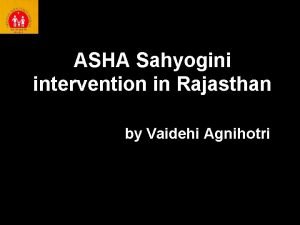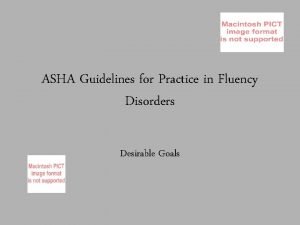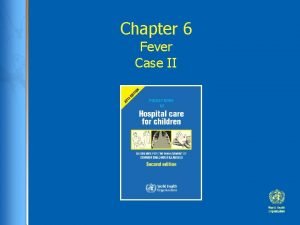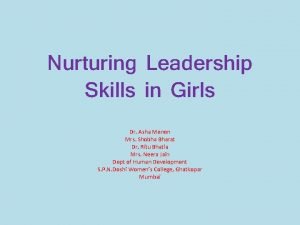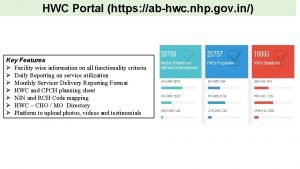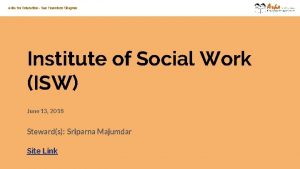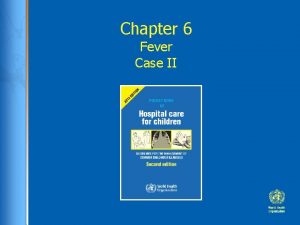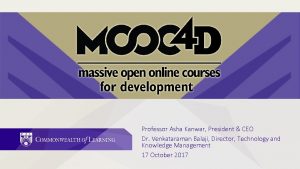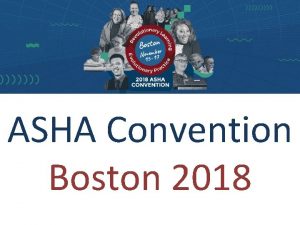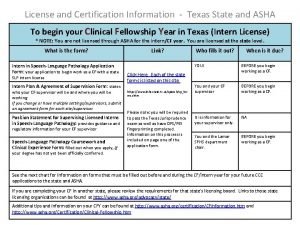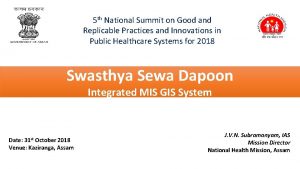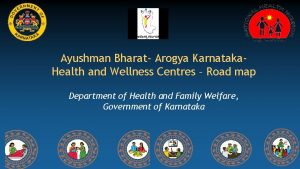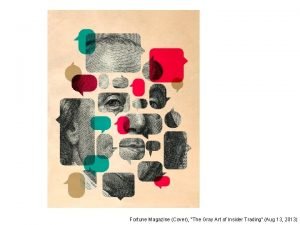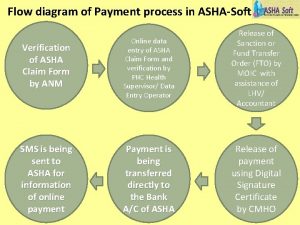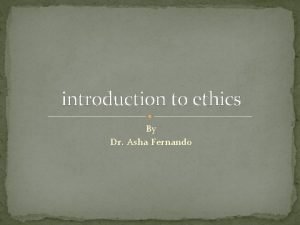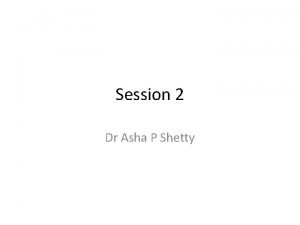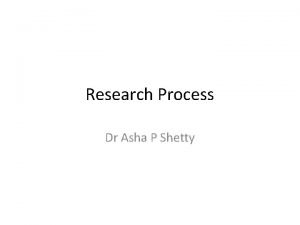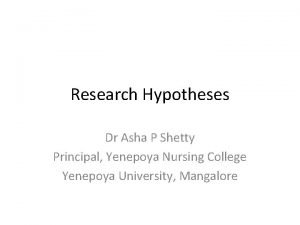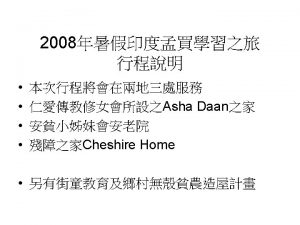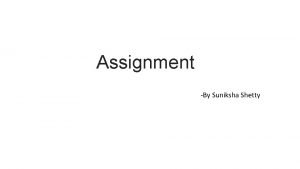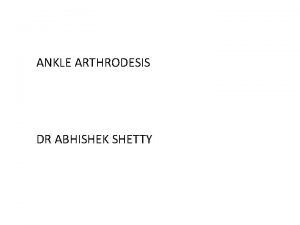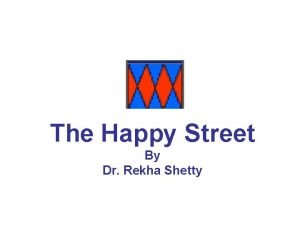Session 2 Dr Asha P Shetty MethodologyApproach Vs

































- Slides: 33

Session 2 Dr Asha P Shetty

Methodology/Approach Vs Design • Research Methodology: Entire strategy for the study, from identification of the problem to final plans of data collection. • Research approach: Research approach is a systematic, controlled, empirical and critical investigation of natural phenomena guided by theory and hypothesis about the relation among such phenomena • Research design: clearly defined structures within which the study is implemented

Basic Types of Approaches • Historical • Survey • Experimental

Research Approach • Time • Availability of data • Relative manipulation of data by researcher • Issues of sampling • Process of data collection • Role of researcher

What is a research problem? § § § Any situation that needs answering It is a felt difficulty or obstacle to a goal A question requiring an answer or solutions. A situation involving a doubt It lacks an available known answer but can be submitted to the process of scientific inquiry

Research problem An enigmatic, perplexing, or troubling condition. Formulating the problem. The process that the researcher uses to arrive at the research problem is called formulating the problem

A research problem can be specified What is wrong or is of concern in this situation? What are the discrepancies in this situation? What is known and not known about the situation? What information is needed to improve the situation? Will a particular intervention work in a clinical situation? • Would another intervention would be more effective? • What changes need to be made to improve this intervention? • • •

Research questions • The specific queries the researcher wants to answer in addressing the research problem. § Are sometimes direct rewordings of statements of purpose, worded as questions § Are sometimes used to clarify or lend specificity to the purpose statement § In quantitative studies, pose queries about the relationships among variables

In qualitative studies, pose queries linked to the research tradition – Grounded theory: process questions – Phenomenology: meaning questions – Ethnography: cultural description questions

Importance of Problem Statement v. They direct investigation i. e. it serves as a guide to the researcher in the course of designing the study. v. They help in specifying precisely the situation under study v. As they are ordinarily generalized rational statements, they enable the researcher to deduce specific empirical manifestations implied by the hypothesis

Sources of Research Problems § Previous research § Empirical interests , curiosity § Experience, clinical fieldwork and practical need § Research literature § Social issues § Theory § Ideas from external sources

Criteria of good research problem v. Significance of the problem v. Research ability of the problem v. Feasibility Ø Time & timing Ø Availability of subjects Ø Cooperation of others Ø Facilities & equipment Ø Money Cost Ø Experience of the researcher Ø Ethically approved v. Interest of the researcher

Problem Statements Ø Declarative form E. g: A study to investigate the relationship between the dependency level of renal transplant patients and their rate of recovery Ø Interrogative form • What is the relationship between dependency of renal transplant patients and their rate of recovery? • Or What are the factors that affect insight in psychosis patients?

Components: Quantitative studies • Identify key study variables • Identify possible relationships among variables • Indicate the population of interest • Suggest, through use of verbs, the nature of the inquiry (e. g. , to test…, to compare…, to evaluate…)

Contd…. : Qualitative studies • Identify the central phenomenon • Indicate the research tradition (e. g. , grounded theory, ethnography) • Indicate the group, community, or setting of interest • Suggest, through use of verbs, the nature of the inquiry (e. g. , to describe…, to discover…, to explore…)

Questions to evaluate a research problem • Does the problem stated clearly, concisely and unambiguously? • Does the problem expresses a relationship between two or more variables? • Does the problem show the direction for empirical testing? • Is it specified the nature of population and the setting? • Has the researcher appropriately delimited the scope of the problem?

• Is there a good match between the research problem and the paradigm within which the research was conducted? • Does problem have a gender bias? • Does the reader get a feel for the magnitude of the problem? • Is background information provided on the research problem? • Can the level of research be identified (descriptive, explanatory, co relational or experimental) • Do the population and variable stated relate to the level of research identified. • Is it in declarative form or interrogative term • Does the study seem researchable based on the variable presented?

Variables • A characteristic or quality that takes on different values, i. e. , that varies from one person to the next • Examples: • Blood type • Weight • Length of stay in hospital 10/29/2020 18

Definition: A characteristic or attribute of a person or object that varies (i. e. takes on different values) within the population under study (e. g. : age, Heart rate etc. ). A variable is a symbol to which numerals or values are assigned e. g. SES is a variable 10/29/2020 19

Example It can vary from – Lower class Numerals assigned 0 Middle Class 1 Upper class 2 10/29/2020 20

Variables § are the central building blocks of quantitative studies § should be defined accurately § should be quantifiable – by valid & relative means 10/29/2020 21

TYPES OF VARIABLES Independent Variable : It’s a variable that stands above and is not dependent on any other. It is stated first in a hypothesis, followed by the dependent variable In experimental research the independent variable is manipulated by the researcher, it is the presumed “cause” & its effect on the dependent variable is observed. criterion variable 10/29/2020 22

Dependent Variable • It is the effect of the action of the independent variable and cannot exist by itself. • It is the outcome variable. • The independent variable is the presumed cause for the resulting effect on the dependent variable • Example: Smoking (IV) Lung cancer (DV) 10/29/2020 23

• Variables are not inherently dependent or independent. A dependent variable in one study could be an independent variable in another study. 10/29/2020 24

Extraneous Variable An uncontrolled variable that greatly influences the results of a study. These lie outside the interest, or the control of the researcher. But can be minimized by the research design & through statistics. 10/29/2020 25

Active Vs Attribute Variables Active variable - that are manipulated or created Attribute variables – measured or observed variables that cannot be manipulated or influenced by the researcher but preexist as characteristics in the investigation. E. g. intelligence, aptitude, attitude ; yet they may be present or vary under population under study 10/29/2020 26

Continuous Vs Categorical Variables • Continuous variable is capable of taking on an ordered set of values within a certain range. E. g. height, weight. • By contrast, a discrete variable is one that has a finite number of values between any two points, representing discrete quantities. E. g. , marital status, gender. 10/29/2020 27

Categorical Variables • • belong to a kind of measurement called nominal i. e. they are two or more subsets of the set of objects being measured. take only a handful of discrete non quantitative values. 10/29/2020 28

Intervening Variable § This variable comes between the dependent & the independent variable. § It cannot be measured or controlled. § These must however be minimized by the researcher 10/29/2020 29

Organismic Variable Those that cannot be changed by manipulation e. g. age, sex, heredity, race etc 10/29/2020 30

Confounding Variables that interfere with the study design & the data gathering process by influencing the subject or the dependent variable 10/29/2020 31

Relationships A bond or connection between variables. • Cause-and-effect (causal) relationship (e. g. , cigarette smoking and lung cancer) • Functional (associative) relationship (e. g. , gender and life expectancy) 10/29/2020 32

Any questions? ? ?
 Shashi kiran shetty net worth
Shashi kiran shetty net worth Dr ravindra shetty
Dr ravindra shetty Reference construction
Reference construction Intorter
Intorter Procces hacker
Procces hacker Types of famil
Types of famil Plexeus
Plexeus Pleomorphic adenoma
Pleomorphic adenoma Asha sahyogini
Asha sahyogini Fluency shaping goals
Fluency shaping goals Asha hemrajani
Asha hemrajani Asha chapter 6
Asha chapter 6 Dr asha menon
Dr asha menon Ab hwc portal app
Ab hwc portal app Asha padmanabhan
Asha padmanabhan Asha ibrahim
Asha ibrahim Asha boe
Asha boe Asha daan- missionaries of charity
Asha daan- missionaries of charity Asha san francisco
Asha san francisco Asha chapter 6
Asha chapter 6 Hbnc and hbyc
Hbnc and hbyc Balaji mooc
Balaji mooc Asha conference 2018 boston
Asha conference 2018 boston Texas slp jurisprudence exam
Texas slp jurisprudence exam Asha noms levels
Asha noms levels Swasthya sewa dapoon assam
Swasthya sewa dapoon assam Asha kanwar rank
Asha kanwar rank Cphc asha app download
Cphc asha app download Raj rajaratnam asha pabla
Raj rajaratnam asha pabla Parisar asha
Parisar asha Asha sangini app
Asha sangini app Payment process flow
Payment process flow Asha
Asha Asha fernando
Asha fernando








